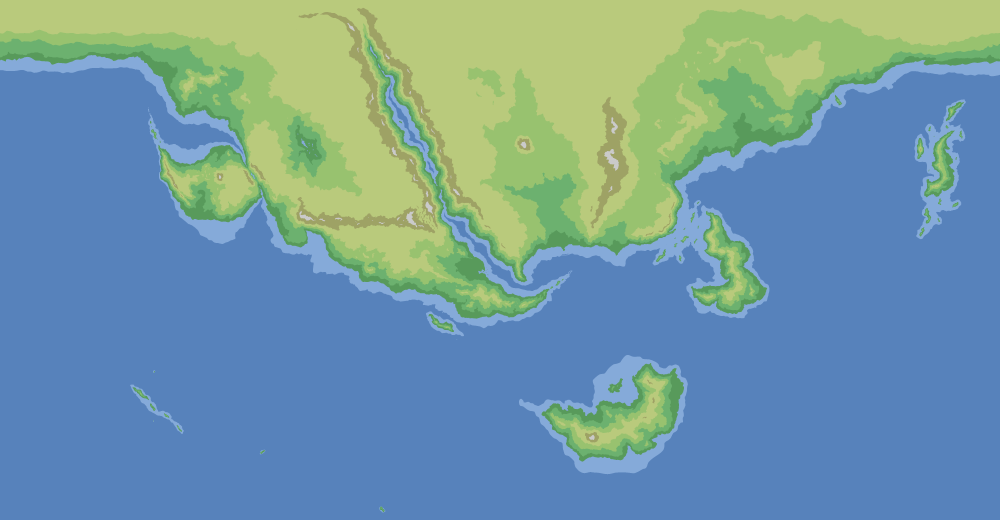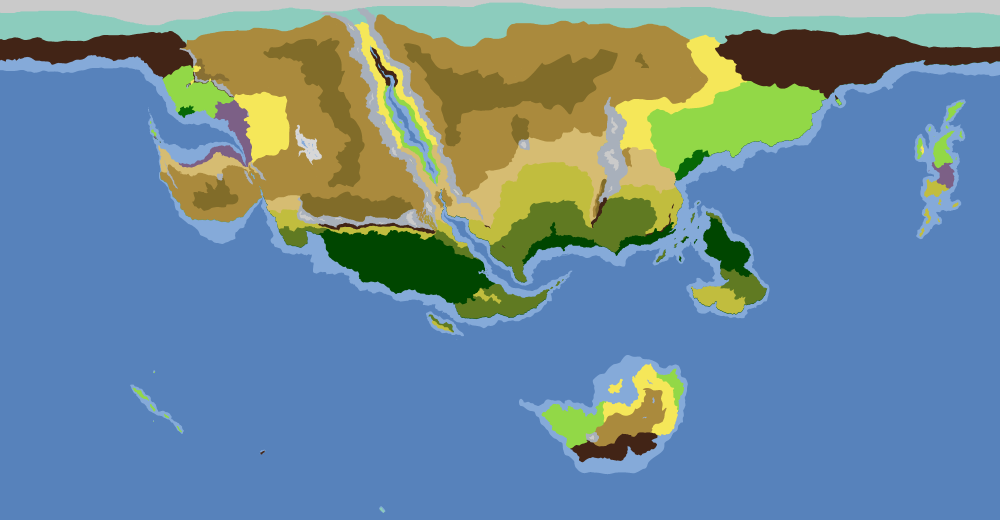A Brief Overview of Temere's Geography
Before we get much further into this project, a brief overview of the geography of the world is in order.

The world of Temere is dominated by the presence of the supercontinent of Prunji, situated almost entirely within the northern hemisphere. Scientists believe it formed roughly 110 million years ago. Now, however, Prunji is being torn apart by tectonic forces, creating great rifts and inland seas. The largest of these is the Rift Sea in the center of the continent; stretching from the horse latitudes up to subpolar climates, it is the start of what will likely be a vast ocean some tens of millions of years in the future. A smaller, but still significant, rift forms as the Hossma subcontinent in the far west breaks off from the rest of Prunji, foriming the Storm Sea. Vast mountain ranges cover the continent, such as the Dual Spines that surround the Rift Sea and the Southern Boundary Mountains that isolate the Xazfrit penninsula from the rest of the supercontinent. It was around the time of the formation of Prunji that the first Pinnatheres evolved, and soon after split into the lineages that would give rise to the "mammals" and the griffons.
Seperated from Prunji by the Sea of Fire, Sylvgoro represents the northernmost fragment of an older supercontinent, one based in the southern hemisphere. Since then, it has moved north into tropical climates and is on a collision course with eastern Prunji. This imminent collision has created a sizable archipelago of volcanic islands, the precursors to a major orogeny. Sylvgoro holds the highest diversity of octomelosaurs in the world, including some lineages completely endemic to it; it's thus hypothesized that the lineage that includes lizipedes and gorgons got their start in the supercontinent that Sylvgoro was once part of.
The other major component of the ancient supercontinent remained in the Southern Hemisphere, named Añata after a legendary island in Rhenish mythology. Very little is known about this continent, as it was only discovered within the past two decades via sattelite imaging, and so far no expeditions have been launched to properly explore it. It's likely that the native fauna is composed largely of octomelosaurs, but this is speculative at this time.
Disconnected from any other landmass, Lejonrün represents a remergance of a sunken continent, once attached to what is now northern Prunji. For centuries, the islands have been an important pitstop for traders travelling between the Storm Sea and the lands of the Jahar Imperium. It's other name, the Griffon Isles, reflects its biota mainly composed of drakes who could fly to the islands and birdpossums that rafted.
Outside of these major landmasses, smaller islands exist, scattered across the vast expanses that make up the world's oceans. The geographers and oceanographers of the Republic divide the borderless waters into three major oceans: the Leviathan Ocean, stretching from Hossma to Jaharia in the north; the Ring Ocean, partially enclosed by Prunji, Sylvgoro, and Añata; and the Southern Ocean, which, as the name suggests, covers the southern seas of the world. Between them, smaller bodies of water exist, such as the Storm Sea, the Sea of Fire, and the Xazfrit Sea.
One last physical geographic trait to note: across the world, there exist four Great Peaks, composite volcanoes whose vast size completely eclipse even the mightiest cones of Earth. Four exist at any one time; as one begins to wane, another begins to form. How this can happen is unknown. At present, these are Mount Horizon in Hossma, Mount Shadow in central Prunji, Mount Rise on Rise Island in Lejonrün, and Mount South in Añata. Each volcano holds the ruins of an ancient civilization at their bases, dated to arround 100,000 to 20,000 years ago. Mount Horizon in particular is rumored to be the base of operations for Purple, but this is uncomfirmed at this time.

Color key:
Prunji is an extremely dry continent, covered as it is by mountains and lands far from the sea. Indeed, on a supercontinent, deserts play a larger role in creating distinct biogeographic zones than bodies of water; for example, the Storm Sea region has a more distinct biota from the more contigous expanse of green in the south and east, and the Rift Sea creates an isolated stretch of habitability distinct from the rest of Prunji. Another, less obvious barrier is the presence of red forests. Unlike the more conventional plants of most of Temere, red forests are composed of shimmertrees, a clade of BioMech with symbiotic red algae, and as such is not ideal habitat for more conventional animals. The largest of these, the Great Glistening Forest of northern Prunji, serves as another way of isolating the Storm Sea from the outside world. On the other hand, shimmertrees (and all BioMech organisms) are closely tied to cold climates, mainly the poles and mountains, and as such have a very disconnecting range, creating isolated ecosystems for those species adapted to them.